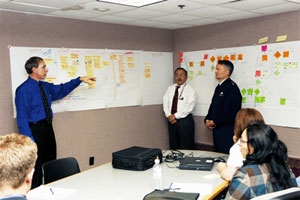And if your task is managing customer support in a bank, or claims adjusting in an insurance company, or the flow of patients through a hospital, the chances are great that you need to fundamentally rethink a value stream that was never designed in any rigorous way and for which no one has clear responsibility. Many of these processes seemingly just happened and have continued to happen for years or decades so that the deficient current state seems sanctioned in some way by history. "It's always been like this. But we are smart and work around problems every day."
What's missing here is what I call the value-stream architect. This is the person, ideally a line manager given a special assignment, who is asked to take responsibility for fundamentally re-thinking an existing value stream to create a lean value-creating process. (This may be a primary value stream directly touching the customer, such as product development or fulfillment from order to delivery, or a support stream necessary to operate some primary stream.)
The first step is to determine customer need and the type of process required to meet the need. Then the value stream can be mapped by walking along the stream with everyone touching it, and the current state can be determined along with the gap in meeting customer need while permitting the organization to prosper. This analysis will suggest potential improvements and the architect then strives for agreement on the best alternative to pursue, followed by experiments using the familiar Plan-Do-Check-Act cycle to determine if the alternative works.
I like the term architect because, in its conventional usage, this is a person who talks with customers to determine their needs for a building and also talks with all the players involved in design and construction (at a minimum, the engineer and the general contractor) to create a process that will deliver the desired value. The difference, of course, is that traditional architects are creating buildings while value-stream architects are creating coherent, lean processes.
This all sounds hard, and it is. Most organizations tackle process improvement as a staff (or consultant) activity at isolated points along extended value streams and often without asking what is really important to the customer or the implications for the whole organization.
 In consequence, the most important processes -- the ones flowing across the organization -- often aren't tackled and, even when they are, the improved process can't be sustained because the new process isn't understood by the line managers who don't see maintaining and improving the entire value stream as their responsibility. (This points to the need to designate a value-stream manager for each process once it is transformed, to continually monitor the performance of the value stream and steadily improve it through kaizen.) In consequence, the most important processes -- the ones flowing across the organization -- often aren't tackled and, even when they are, the improved process can't be sustained because the new process isn't understood by the line managers who don't see maintaining and improving the entire value stream as their responsibility. (This points to the need to designate a value-stream manager for each process once it is transformed, to continually monitor the performance of the value stream and steadily improve it through kaizen.)
I wish we in the Lean Community could simply draw on Toyota or Honda practice in pursuing lean process architecture. But I fear we can't. I've made many inquiries, but I haven't found any clarity in the way those organizations design robust, lean value streams for their value-creating activities outside the factory. And, in any case, the vast majority of the world's processes operate in organizations far removed from manufacturing. So, I think we are pretty much on our own as lean thinking continues to spread far beyond its original point of origin.
What we need now is experiments in many industries in ways to make value-stream architecture a core skill of line management.
To cite one example of the type of experimentation needed, my long-time co-author Dan Jones and his collaborators have been working with several healthcare organizations in the UK to create value-stream architects to transform the flow of patients all the way through the hospital. This end-to-end process is particularly challenging because the many steps involved from admission to discharge have never been treated as a connected activity and -- in the few cases where they have -- neither patient nor organizational needs have been clearly specified.
Dan has recently asked his collaborators, Marc Baker and Ian Taylor, to write up their approach in a workbook, Making Hospitals Work, and I hope members of the Lean Community in every industry will find it of interest. In reviewing their work, I find it particularly important that they have embedded value-stream redesign in an A3 analysis to focus on the needs of the patient and the organization before tackling patient flow. And their discussion is truly provocative on the role of the value-stream manager (the term they use instead of architect) and his or her key contribution as the cross-departmental, horizontal force for transformation in an otherwise vertical organization.
Every industry and organization is different, and we will need a lot of experiments in the years ahead if we are going to make everything work. Indeed, I believe that systematic experimentation to discover the best way for lean managers to create lean value streams for every process in every industry is the most important task before the Lean Community.
Do we have a shortage of “value stream architects” in our supply chains? Where is the need to greatest? Can Lean be an important tool to reduce healthcare costs and/or improve quality? Let us know yur thoughts at the Feedback button below.
SCDigest is Twittering!
Follow us now at https://twitter.com/scdigest |